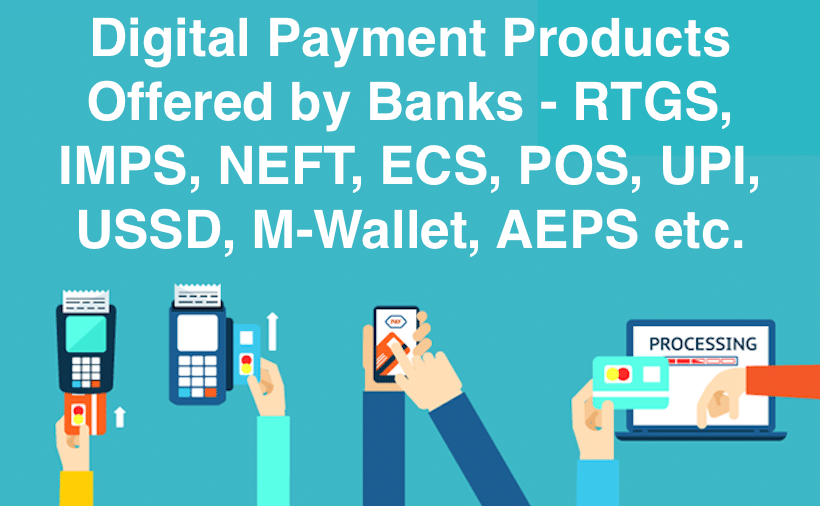The digital drive in banking transactions came to India soon after the liberalization in 1990s. Since then various technology-enabled digital payment modes have been offered by the banks in India. Following are the most popular digital payment/transactions modes made available by Indian banks.
Quick Links
Digital Payment Products Offered by Banks
Real Time Gross Settlement (RTGS):
RTGS is an electronic payment system maintained by RBI that enables individuals to transfer funds between banks. It is generally meant for high-value transaction as the minimum amount for making RTGS is Rs.200000 with no upper limit of transaction.
National Electronic Fund Transfer (NEFT):
NEFT is a fund transfer system facilitating nation-wide transfer of funds to both account holders in NEFT enabled branches of a bank as well as walk in customers who do not have a bank account. Individuals, firms as well as corporate firms can avail this facility to transfer funds to any other party having a bank account with the same or different bank branch. Maximum fund transfer limit for NEFT is Rs.50000 per transaction.
Immediate Payment Service (IMPS):
IMPS, unlike NEFT and RTGS, is a 24×7 service (available in bank holidays as well) facilitating instant and secured electronic fund transfer using mobile phones or ATMs and is safe as well as economical. The service is available in between person (P) on one side and either another person or an account (A) or a merchant on the other side.
Electronic Clearing System (ECS):
ECS is mainly used for paying utility bills such as electricity, insurance premium, telephone, etc. It uses the service of a clearing house in order to transfer funds from one bank account to another. This system is useful for bulk transfers and transfers of repetitive nature. For example, in order to distribute dividend, salary or pension, the institutions use ECS (credit), on the other hand for making regular payments to firms or repayment of loans via EMI, individuals use ECS (Debit).
Point of Sale (POS):
This is an electronic device acting as a sales terminal for processing payments at different malls or retail outlets. It is the most common machine used for debit or credit card payments in which the machine reads the card punched or swiped and checks whether there is sufficient funds in the customer’s account and then accordingly transfers funds from customer’s account to seller’s account.
Mobile Banking:
It is a service offered by a bank or any financial institution through which a customer conducts financial transactions remotely by using only a smartphone or a tab. Unlike internet banking which is conducted through bank’s own website, it is done through a software, usually called an app. It is a 24×7 service and can be used for transactions other than fund transfer as well, such as obtaining balances, statements etc. However, the availability of other services may vary from bank to bank.
M-Wallets:
Digital or Mobile Wallet services are provided by many banks as well as other approved financial institutions like Paytm, Freecharge, Phonepe etc. Money can be added to the wallets using debit or credit cards or internet banking and then can be used for an array of transactions including payment of utility bills, shopping etc. However, an active mobile connection or e-mail id is a must.
United Payment Interface (UPI):
This digital platform came into existence on 11th April, 2016. It was developed by National Payment Corporation of India under the assistance and regulation of RBI and IBA (Indian Banks Association). UPI is a hassle-free digital interface for transferring fund without the need of entering the extensive details relating to bank account number, IFSC code, bank account type, bank name and so on. This is basically an advanced or modified version of IMPS (Immediate Payments Service).
Presently 101 banks have adopted this technology (up to November 2018). Registration in UPI is a onetime process after which funds may be transferred using mobile devices. The BHIM (Bharat Interface for Money) app developed by NPCI is alsoan UPI based app which facilitates sending and receiving of money using VPA or global address or even through QR code scanning along with all other services of a UPI based app.
Unstructured Supplementary Service Data (USSD):
Unlike UPI, it does not require a smartphone and access to internet but use specified codes for transactions. This USSD interface (also called *99# service) was developed by NUUP (National Unified USSD Platform) to overcome the problem of poor internet connectivity in rural areas. It came up with the option of 12 regional languages in addition to English. Currently, this service is being offered by 51 banks. BHIM app as mentioned above can come up with USSD features as well.
Aadhar Enabled Payment System (AEPS):
AEPS is developed to bring the bank at the customers’ places and also to enable interoperability among different systems of different banks. AEPS has thereby facilitated operations of Aadhar Enabled Bank Account (AEBA) for financial inclusion and direct benefit transfer to the eligible beneficiaries under different social security schemes







